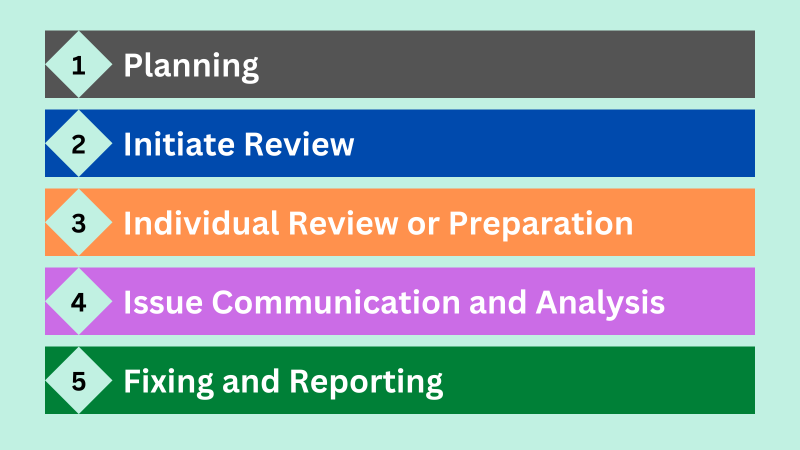
The review process includes the following five main activities:
- Planning
- Initiate Review
- Individual Review or Preparation
- Issue Communication and Analysis
- Fixing and Reporting
Each activity consists of sub-activities. Let's go through each activity with sub-activities associated with it.
1. Planning
The review process starts with planning. Management is responsible for review planning. Activities involved in the planning are:
- Defining Scope: Determining the scope, which includes the objective of the review, what documents or parts of documents to review, and the quality characteristics to be evaluated. Each review should have a clear objective.
- Analyzing Risks: Review planning should address the risks associated with technical factors, organizational factors, and people issues when performing reviews.
- Estimating effort and timeframe: Planning must ensure that each organization is allocating sufficient time for required reviewers to prepare for, and participate in, the reviews at appropriate points in the project schedule. Time should also be planned for any required technical or process training for the reviewers. Management supports the review process by incorporating adequate time for review activities in project schedules.
Identifying review characteristics: Planning identifies review characteristics such as the review type with roles, activities, and checklists. - Allocating Roles: During planning, people are selected to participate in the review, and roles are assigned. People with the right skills and perspectives should be involved in the review.
- Defining the entry and exit criteria: Entry and Exit Criteria are defined for more formal review types (e.g., inspections)
- Checking fulfillment of Entry Criteria: During planning, we check that entry criteria are met (for more formal review types)
2. Initiate Review
Before initiating a formal review, fulfillment of the review prerequisites (as defined in the procedure or in the list of entry criteria) should be confirmed by the review leader. Sub activities are:
- Distributing the work product: The distribution of the work products and other materials can be done physically or by electronic means, such as issue log forms, checklists, and related work products.
- Educating Participants: Explain the scope, objectives, process, roles, and work products to the participants and provide adequate training if required. All review participants should have formal review training to understand their respective roles better.
- Answering Queries: Answering any questions that participants may have about the review.
3. Individual Review (i.e., Individual Preparation)
Activities performed during the review of a work product are:
- Reviewing Work Products: Reviewing all or part of the work product.
- Recording: Noting potential defects, recommendations, and questions during work product review.
4. Issue Communication and Analysis
The following activities are performed while analyzing and communicating issues:
- Communicating Defects: Communicating identified potential defects during review meetings or other means.
- Analyzing Defects: Analyzing potential defects, assigning ownership and status to them.
- Evaluating Quality Characteristics: and documenting them
- Evaluating the Review Findings: Evaluate the review findings against the exit criteria to make a review decision like rejected, major changes needed, accepted, or minor changes needed.
5. Fixing and Reporting
During Fixing and Reporting. The following activities are done:
- Creating Defect Reports: Creating defect reports for those findings that require changes to a work product
- Fixing Defects: Generally, the author fixes the defects in the work product reviewed.
- Communicating Defects: Communicating defects to the appropriate person or team (when found in a work product related to the work product reviewed)
- Recording Defect Status: Recording updated status of defects (in formal reviews), potentially including the agreement of the comment originator. The scribe or Recorder is responsible for this activity.
- Gathering metrics: The review leader should define adequate metrics for review evaluation during test planning. Review leaders must ensure that metrics are available to: Evaluate the quality of the reviewed item, Evaluate the cost of conducting the review and Evaluate the downstream benefit of conducting the review.
- Checking Exit Criteria: Checking that exit criteria are met (for more formal review types)
- Accepting the Work Product: Finally, accept the work product when the review is done and exit criteria are reached.
- Log in to post comments